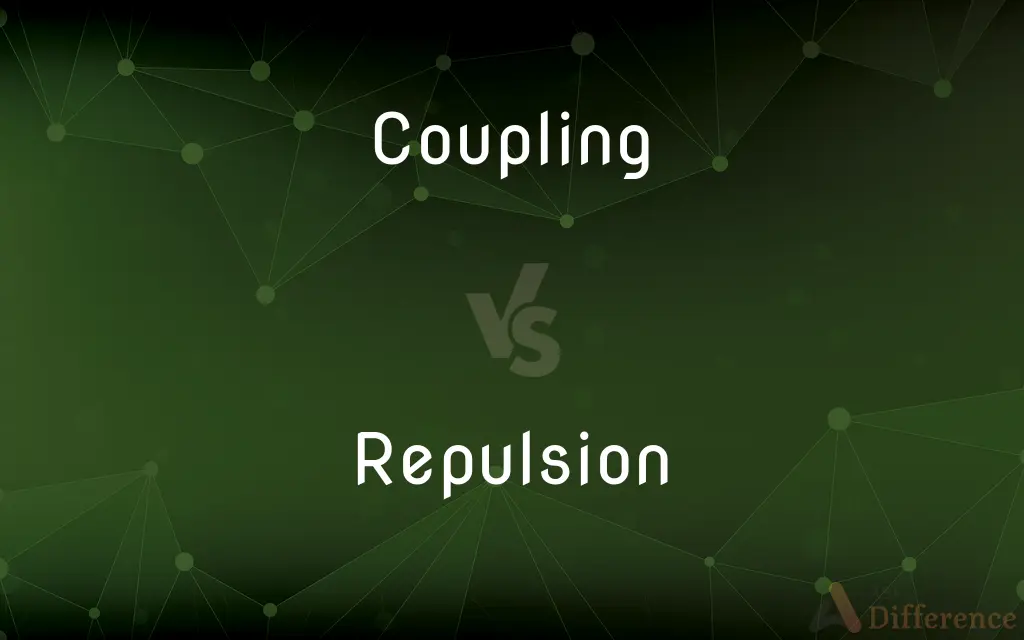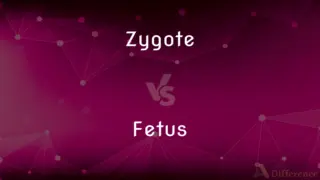Coupling vs. Repulsion — What's the Difference?
Edited by Tayyaba Rehman — By Maham Liaqat — Updated on March 20, 2024
In genetics, coupling refers to linked genes being inherited together on the same chromosome, while repulsion indicates linked genes inherited on separate chromosomes, leading to different phenotypic expressions.

Difference Between Coupling and Repulsion
Table of Contents
ADVERTISEMENT
Key Differences
Coupling, or cis configuration, occurs when two or more genes that are close together on the same chromosome are inherited together more often than not. This phenomenon is due to the genes being physically linked, reducing the likelihood of being separated during crossing over in meiosis. Repulsion, or trans configuration, happens when linked genes are inherited on separate homologous chromosomes, leading to a higher probability of recombination between them. This means that one chromosome carries one dominant and one recessive allele for two different traits, while its homolog carries the complementary combination.
The genetic concepts of coupling and repulsion have significant implications for understanding inheritance patterns and predicting the outcomes of genetic crosses. Coupling tends to preserve the parental combinations of traits, leading to offspring that resemble their parents in terms of linked traits. In contrast, repulsion increases genetic diversity by promoting new combinations of traits through recombination.
Identifying whether linked genes are in coupling or repulsion is crucial for genetic mapping and breeding programs. It helps researchers and breeders predict the likelihood of certain trait combinations and select for desirable traits more effectively. This understanding is applied in fields such as agriculture to develop crop varieties with optimal combinations of traits for yield, resistance to diseases, and other desirable characteristics.
The distinction between coupling and repulsion underscores the complexity of genetic inheritance and the role of chromosome behavior in determining phenotypic outcomes. While Mendel's laws provide the foundation for genetics, the concepts of coupling and repulsion add depth to our understanding of how traits are passed from one generation to the next, especially in the context of linked genes.
Comparison Chart
Definition
Linked genes inherited together on the same chromosome
Linked genes inherited on separate chromosomes
ADVERTISEMENT
Genetic Outcome
Preserves parental combinations of traits
Promotes recombination and new trait combinations
Phenotypic Expression
More likely to resemble parental phenotypes
Increased genetic diversity in offspring
Importance
Aids in predicting inheritance patterns and breeding
Enhances understanding of genetic diversity and mapping
Application
Used in genetic mapping and selective breeding
Crucial for breeding programs aiming for specific traits
Compare with Definitions
Coupling
Linked genes inherited together.
In coupling, a pea plant with round yellow seeds (RRYY) tends to produce offspring with the same traits.
Repulsion
Linked genes on separate chromosomes.
In repulsion, a pea plant may have round seeds (R) and green seeds (y) on one chromosome and wrinkled yellow seeds (rY) on the other.
Coupling
Important for selective breeding.
In agriculture, coupling is exploited to maintain desirable trait combinations in crop varieties.
Repulsion
Promotes new trait combinations.
Repulsion increases the chances of offspring with different trait combinations than their parents.
Coupling
Preserves parental traits.
Coupling results in offspring that closely resemble the parental phenotype regarding linked traits.
Repulsion
Increases genetic diversity.
Repulsion leads to greater phenotypic variation among offspring due to the increased likelihood of recombination.
Coupling
Cis configuration.
Genes in coupling are in a cis configuration, meaning dominant or recessive alleles of linked genes are on the same chromosome.
Repulsion
Useful in creating hybrid varieties.
Repulsion is important in breeding programs aimed at combining specific traits from different parent lines to create hybrids with new trait combinations.
Coupling
Reduces genetic diversity.
Because coupling keeps gene combinations intact, it results in less phenotypic variation among offspring.
Repulsion
Trans configuration.
Genes in repulsion are in a trans configuration, with one chromosome carrying a dominant allele for one gene and a recessive allele for another, and vice versa.
Coupling
A coupling is a device used to connect two shafts together at their ends for the purpose of transmitting power. The primary purpose of couplings is to join two pieces of rotating equipment while permitting some degree of misalignment or end movement or both.
Repulsion
The act of repulsing or the condition of being repulsed
The repulsion of an attack on the fort.
Coupling
The act of linking together or forming couples.
Repulsion
Extreme aversion
Felt nothing but repulsion at the remark.
Coupling
A device that links or connects.
Repulsion
(Physics) The force that causes particles or bodies to repel one another, as from having the same electric charge or magnetic polarity.
Coupling
(Electronics) The transfer of electricity from one circuit to another.
Repulsion
The act of repelling or the condition of being repelled.
Coupling
(Chemistry) Facilitation or acceleration of one chemical process due to the presence or action of another.
Repulsion
An extreme dislike of something, or hostility to something.
Coupling
The body part of a four-footed animal that connects the hindquarters to the forequarters.
Repulsion
(physics) The repulsive force acting between bodies of the same electric charge or magnetic polarity.
Coupling
Act of joining together to form a couple.
Repulsion
The act of repulsing or repelling, or the state of being repulsed or repelled.
Coupling
A device that couples two things together.
Repulsion
A feeling of violent offence or disgust; repugnance.
Coupling
(software engineering) The degree of reliance between two or more software modules.
Repulsion
The power, either inherent or due to some physical action, by which bodies, or the particles of bodies, are made to recede from each other, or to resist each other's nearer approach; as, molecular repulsion; electrical repulsion.
Coupling
(electronics) A connection between two electronic circuits such that a signal can pass between them.
Repulsion
The force by which bodies repel one another
Coupling
(physics) The property of physical systems that they are interacting with each other
Repulsion
Intense aversion
Coupling
Present participle of couple
Repulsion
The act of repulsing or repelling an attack; a successful defensive stand
Coupling
A device or contrivance which serves to couple or connect adjacent parts or objects; as, a belt coupling, which connects the ends of a belt; a car coupling, which connects the cars in a train; a shaft coupling, which connects the ends of shafts.
Coupling
A connection (like a clamp or vise) between two things so they move together
Coupling
A mechanical device that serves to connect the ends of adjacent objects
Coupling
The act of pairing a male and female for reproductive purposes;
The casual couplings of adolescents
The mating of some species occurs only in the spring
Common Curiosities
Why is understanding coupling and repulsion important for breeders?
Understanding these concepts helps breeders predict the outcomes of crosses, enabling them to select parent organisms that will produce offspring with desired trait combinations.
What is the significance of coupling in genetics?
Coupling is significant for understanding how linked traits are inherited together, aiding in genetic mapping and selective breeding to preserve desirable traits.
How does repulsion contribute to genetic diversity?
Repulsion contributes to genetic diversity by increasing the chances of recombination between linked genes, leading to offspring with new combinations of traits.
Can the arrangement of genes change from coupling to repulsion or vice versa?
The arrangement can change through crossing over during meiosis, where segments of chromosomes are exchanged, potentially altering the linkage configuration between genes.
How do geneticists use the concepts of coupling and repulsion in research?
Geneticists use these concepts to map gene locations on chromosomes, understand genetic disorders, and develop strategies for breeding plants and animals with desired traits.
How do coupling and repulsion affect genetic linkage maps?
Genetic linkage maps are created based on the likelihood of genes being inherited together. Coupling and repulsion patterns help determine the relative positions and distances between genes on these maps.
How does the distance between genes influence coupling and repulsion?
The closer two genes are on a chromosome, the more likely they are to be inherited together (coupling), while genes farther apart are more likely to undergo crossing over, leading to repulsion.
How are coupling and repulsion detected in genetic studies?
They are detected through genetic crosses and analyzing the phenotypes of offspring, often using test crosses to reveal the underlying genotypes and linkage configurations.
What role does crossing over play in coupling and repulsion?
Crossing over during meiosis can break the physical linkage between genes, affecting their coupling or repulsion relationships by exchanging alleles between homologous chromosomes, leading to new allele combinations.
Are there any disorders or conditions associated with gene coupling or repulsion?
Specific genetic disorders might not be directly caused by coupling or repulsion, but understanding these relationships can be crucial in studying diseases linked to certain gene combinations.
Can environmental factors influence coupling and repulsion?
While environmental factors do not directly alter the genetic mechanisms of coupling and repulsion, they can affect the expression of traits and the selection of organisms for breeding based on those traits.
What challenges do researchers face when studying linked genes in coupling and repulsion configurations?
Challenges include accurately identifying linked genes, determining their distance and orientation on chromosomes, and predicting their behavior during meiosis, especially in organisms with complex genomes.
Do coupling and repulsion affect Mendel's laws of inheritance?
While Mendel's laws form the basis of genetics, coupling and repulsion provide a more nuanced understanding of inheritance by explaining exceptions to independent assortment due to gene linkage.
How do modern genetic technologies impact the study of coupling and repulsion?
Technologies like CRISPR-Cas9 and genome sequencing have advanced our ability to study gene linkage, allowing for more precise manipulation and understanding of gene relationships, including coupling and repulsion.
Share Your Discovery

Previous Comparison
Zygote vs. Fetus
Next Comparison
Orchestra vs. BandAuthor Spotlight
Written by
Maham LiaqatEdited by
Tayyaba RehmanTayyaba Rehman is a distinguished writer, currently serving as a primary contributor to askdifference.com. As a researcher in semantics and etymology, Tayyaba's passion for the complexity of languages and their distinctions has found a perfect home on the platform. Tayyaba delves into the intricacies of language, distinguishing between commonly confused words and phrases, thereby providing clarity for readers worldwide.














































